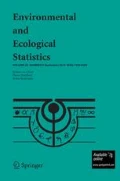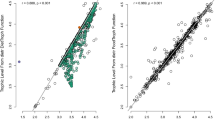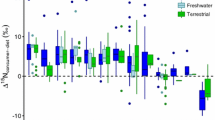Abstract
Stable isotope sourcing is used to estimate proportional contributions of sources to a mixture, such as in the analysis of animal diets and plant nutrient use. Statistical methods for inference on the diet proportions using stable isotopes have focused on the linear mixing model. Existing frequentist methods provide inferences when the diet proportion vector can be uniquely solved for in terms of the isotope ratios. Bayesian methods apply for arbitrary numbers of isotopes and diet sources but existing models are somewhat limited as they assume that trophic fractionation or discrimination is estimated without error or that isotope ratios are uncorrelated. We present a Bayesian model for the estimation of mean diet that accounts for uncertainty in source means and discrimination and allows correlated isotope ratios. This model is easily extended to allow the diet proportion vector to depend on covariates, such as time. Two data sets are used to illustrate the methodology. Code is available for selected analyses.
Similar content being viewed by others
References
Bedrick EJ, Christensen R, Johnson W (1996) A new perspective on priors for generalized linear models. J Am Stat Assoc 910(436): 1450–1460
Ben-David M, Hanley TA, Klein DR, Schell DM (1997) Seasonal changes in diets of coastal and riverine mink: the role of spawning pacific salmon. Can J Zool 75: 803–811
Bickford CP, Mcdowell NG, Erhardt EB, Powers HH, Hanson DT (2009) High frequency field measurements of diurnal carbon isotope discrimination and internal conductance in a semi-arid species, juniperus monosperma. Plant Cell Environ 320(7): 796–810
Bond A, Diamond A (2011) Recent bayesian stable-isotope mixing models are highly sensitive to variation in discrimination factors. Ecol Appl 21: 1017–1023
Bowen GJ, Revenaugh J (2003) the isotopic composition of modern meteoric precipitation. Water Resour Res 390(10): 1299
Caut S, Angulo E, Courchamp F (2009) Variation in discrimination factors (Δ 15 N and Δ 13 C): the effect of diet isotopic values and applications for diet reconstruction. J Appl Ecol 460(2): 443–453
Currin CA, Newell SY, Paerl HW (1995) The role of standing dead spartina alterniflora and benthic microalgae in salt marsh food webs: considerations based on multiple stable isotope analysis. Marine Ecol Prog Ser Oldendorf 1210(1): 99–116
Deines P, Wooller MJ, Grey J. (2009) Unravelling complexities in benthic food webs using a dual stable isotope (hydrogen and carbon) approach. Freshw Biol 540(11): 2243–2251
DeNiro M, Epstein v. (1981) Influence of the diet on the distribution of nitrogen isotopes in animals. Geochim Cosmochim Acta 48: 341–351
Ehleringer JR, Bowen GJ, Chesson LA, West AG, Podlesak DW, Cerling TE (2008) Hydrogen and oxygen isotope ratios in human hair are related to geography. Proc Natl Acad Sci 1050(8): 2788
Evans Ogden LJ, Hobson KA, Lank DB (2004) Blood isotopic (δ 13C and δ 15N) turnover and diet-tissue fractionation factors in captive dunlin (Calidris alpina pacifica). The Auk 1210(1): 170–177
Evans Ogden LJ, Hobson KA, Lank DB, Bittman S (2005) Stable isotope analysis reveals that agricultural habitat provides an important dietary component for nonbreeding Dunlin. Avian Conserv Ecol 10(3). http://www.ace-eco.org/vol1/iss1/art3/
Felicetti LA, Schwartz CC, Rye RO, Haroldson MA, Gunther KA, Phillips DL, Robbins CT (2003) Use of sulfur and nitrogen stable isotopes to determine the importance of whitebark pine nuts to yellowstone grizzly bears. Can J Zool 81: 763–770
Finlay JC, Doucett RR, McNeely C (2010) Tracing energy flow in stream food webs using stable isotopes of hydrogen. Freshw Biol 550(5): 941–951
Gelman A, Goegebeur Y, Tuerlinckx F, Van Mechelen I (2000) Diagnostic checks for discrete data regression models using posterior predictive simulations. J R Stat Soc Ser C (Appl Stat) 490(2): 247–268
Hobson KA (1999) Tracing origins and migration of wildlife using stable isotopes: a review. Oecologia 1200(3): 314–326
Hobson K, Wassenaar L (1999) Stable isotope ecology: an introduction Oecologia, Springer 120(3):312–313
Hobson, KA, Wassenaar, LI (eds) (2008) Tracking animal migration with stable isotopes. Academic Press, London
Inger R, Bearhop S (2008) Applications of stable isotope analyses to avian ecology. Ibis 1500(3): 447–461
Jones AW, Dalton CM, Stowe ES, Post DM. (2010) Contribution of declining anadromous fishes to the reproductive investment of a common piscivorous seabird, the double-crested cormorant (phalacrocorax auritus). The Auk 1270(3): 696–703
Kendall, C, McDonnell, JJ (eds) (1998) Isotope tracers in catchment hydrology. Elsevier, Amsterdam
Lunn DJ, Thomas A, Best N, Spiegelhalter D (2000) WinBUGS—a Bayesian modelling framework: concepts, structure, and extensibility. Stat Comput 100(4): 325–337
Martínez del Rio C, Wolf BO (February 2005) Mass-balance models for animal isotopic ecology. In: Matthias Starck J, Tobias Wang , Tobias Wang (eds) Physiological and ecological adaptations to feeding in vertebrates, chapter 6. Science Publishers, Enfield, pp 141–174
MATLAB (2010) Version 7.10.0 (R2010a) The MathWorks, Natick
Minagawa M, Wada E (1984) Stepwise enrichment of 15N along food chains: further evidence and the relation between δ 15N and animal age. Geochim Cosmochim Acta 48: 1135–1140
Moore JW, Semmens BX (2008) Incorporating uncertainty and prior information into stable isotope mixing models. Ecol Lett 11: 470–480
Newsome SD, Martinez del Rio C, Bearhop S, Phillips DL (2007) A niche for isotopic ecology. Frontiers Ecol Environ 50(8): 429–436
Oulhote Y, Bot BL, Deguen S, Glorennec P (2010) Using and interpreting isotope data for source identification. TrAC Trends Anal Chem
Parnell A, Jackson A (2008) Siar: stable isotope analysis in R 2008. R package version 3.3.
Parnell AC, Inger R, Bearhop S, Jackson AL (2010) Source partitioning using stable isotopes: coping with too much variation. PLoS ONE 50(3): e9672
Peterson BJ, Fry B (1987) Stable isotopes in ecosystem studies. Annu Rev Ecol Syst 18: 293–320
Peterson BJ, Howarth RW (1987) Sulfur, carbon, and nitrogen isotopes used to trace organic matter flow in the salt-marsh estuaries of sapelo island, georgia. Limnol oceanogr 32(6): 1195–1213
Phillips DL (2001) Mixing models in analyses of diet using multiple stable isotopes: a critique. Oecologia 127: 166–170
Phillips DL, Gregg JW (2001) Uncertainty in source partitioning using stable isotopes. Oecologia 127: 171–179
Phillips DL, Gregg JW (2003) Source partitioning using stable isotopes: coping with too many sources. Oecologia 1360(2): 261–269
Phillips DL, Koch PL (2002) Incorporating concentration dependence in stable isotope mixing models. Oecologia 130: 114–125
Post DM (2002) Using stable isotopes to estimate trophic position: models, methods, and assumption. Ecology 83: 703–718
Rundel PW, Ehleringer JR, Nagy KA (1989) Stable isotopes in ecological research. Springer, New York
Semmens BX, Ward EJ, Moore JW, Darimont CT (2009) Quantifying inter-and intra-population niche variability using hierarchical Bayesian stable isotope mixing models. PLoS One 40(7): e6187
Solomon CT, Cole JJ, Doucett RR, Pace ML, Preston ND, Smith LE, Weidel BC (2009) The influence of environmental water on the hydrogen stable isotope ratio in aquatic consumers. Oecologia 1610(2): 313–324
Solomon CT, Carpenter SR, Clayton MK, Cole JJ, Coloso JJ, Pace ML, Vander Zanden MJ, Weidel BC (2011) Terrestrial, benthic, and pelagic resource use in lakes: results from a three-isotope Bayesian mixing model. Ecology 920(5): 1115–1125
Ward EJ, Semmens BX, Schindler DE (2010) Including source uncertainty and prior information in the analysis of stable isotope mixing models. Environ Sci Technol 440(12): 4645–4650 ISSN 0013-936X
Author information
Authors and Affiliations
Corresponding author
Additional information
Handling Editor: Steve Rathbun.
Rights and permissions
About this article
Cite this article
Erhardt, E.B., Bedrick, E.J. A Bayesian framework for stable isotope mixing models. Environ Ecol Stat 20, 377–397 (2013). https://doi.org/10.1007/s10651-012-0224-1
Received:
Revised:
Published:
Issue Date:
DOI: https://doi.org/10.1007/s10651-012-0224-1




